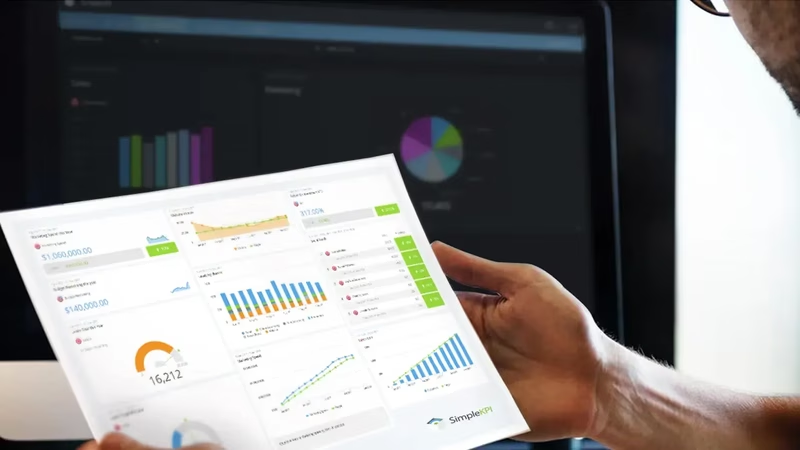No matter what organisation, sector or profession you ply your trade, you've probably heard of Key Performance Indicators. If not, then it's time to introduce this must have addition to your business toolbox.
It's widely understood that the practise of measuring any kind of business process, from an individual's time spent on a job to a global organizations revenue stream, helps staff, managers and stakeholders focus on those factors that influence performance.
For example, tracking the number of customer complaints provides an easy to understand measurement of how well a product or service is being consumed or experienced by your customers. This information can lead to product improvements or raise service levels. Essentially, driving changes that increase efficiencies, competitiveness and growth.
For many, simply measuring something with the intent to improve is enough, and whilst monitoring basic metrics is a good start, there is oh so much more you could be getting back.
The Key Performance Indicator (KPI)
Whilst I'll leave the complete definition of KPIs for another page, it's worth remembering what sets these apart from simple metrics.
Metrics
A metric is a measurement that can be monitored. They encapsulate the complete sphere of business functions, such as the number of calls, appointments or even time travelling to clients. These are the kind of measurements that may or may not have targets but can be used to monitor any areas of business performance.
KPIs
A KPI essentially gives a metric elevated purpose. They are aligned to strategic goals and have clearly defined objectives. They target critical areas of business performance such as revenue. Displaying how effectively an organisation is performing against those Key objectives such as revenue growth.
Both Metrics and KPIs share similar traits. So, what is the best way to learn about KPIs? How are they constructed? And what makes them Key? I believe the best way to discover how these powerful business tools work is to see them in context based real-world examples. So, here's 20 KPIs covering 4 different business areas for you to browse at your leisure:
Human Resources:
-
Absenteeism
Illness, delays and unforeseen absence is an important indicator in determining staffing levels. Monitoring this indicator can help with staffing predictions based on seasonal trends. This KPI combined with working hourly pay can determine the cost impact of absenteeism on the company. -
Average time to Hire
The indicator measures the time in days, from either a new or current position being vacant to the time that a confirm offer has been accepted. Over time this measurement can help highlight typical recruitment times for various skill levelled roles. -
Cost per Hire
Taking the total internal and external recruitment costs divided by the total number of hires will offer an indicator (over time) of the average cost to fill a single role. It offers an indication of effectiveness in the recruitment process. However, this does not reflect the quality of hire. -
Turnover Rate
By dividing the Number of employees leaving the business, by the average number of employees - can shed light on potential issues such as loss of talent, managerial and work place problems. Context is really import with this measurement as conversely; a low turnover rate can indicate lack of new ideas being brought to the business. -
Vacation Days used Percentage
This useful indicator allows Human Resources to see how well employees are managing their work life balance. It also provides information regarding seasonal staffing levels and company exposure to productivity.
View more Human Resource focused KPI Examples in this template.
Software as a Service (SaaS)
-
Churn Rate
The most important health indicator for any subscription based business is Churn Rate. This KPI shows the relationship between New Customers and those that are cancelling. A positive measure in this calculation is an indicator that the subscription base is contracting. -
Monthly Recurring Revenue (MRR)
MRR is the total amount of revenue you're expecting from all current and new subscribers in a month. It's a Key Indicator that can be used for insight when analysing the impact of new pricing strategies or upgrades. This indicator can also be tracked as month on month growth using percentages. -
Cost to Acquire Customers (CAC)
As SaaS business models rely on materializing revenue from customers over an extended period, it's imperative to know what the cost is to acquire customers are. This indicator considers all the sales and marketing costs, divided by New Customers. Armed with this information it's possible to get an indication of how successfully a SaaS business can scale. -
Conversion Rate
Even if you've managed to get thousands of trials a month, if you can't convert them into paid subscribers you won't be in business for long. Taking the number of subscribers divided by the number of trials sets the trial / conversion rate. The KPI can provide an early warning indicator for your on-boarding process, customer support and any new updates. -
Customer lifetime value (CLV)
This indicator provides the average amount of revenue you can expect from customer during their relationship with your product or service. This KPI is calculated using the customer lifetime (Churn Rate by number of Customers) and the Average revenue per account (ARPA).
Retail
-
Number of Customers
It goes without saying that the more visitors that come to your website or shop the more likely you are to make a sale. Tracking the number of eventual customers from these visitors can offer an indication of how popular your products are or future seasonal staffing and stock needs. -
Average Purchase Order
Retail outlets need be aware of price sensitivity. Too cheap, the lower the margin, the higher the number of staff, the more units that need to be sold. Too expensive, less sales. Average purchase order is an important indicator for sales price points, tracking the number of sales and the value of those sales. -
Customer Satisfaction Index (CSI)
Probably the hardest Retail indicator to measure is CSI. Each retailer and their products / services are very diverse. However, a custom designed question using a 1-10 scale such as, how pleased were you with your visit to big business today? – will help at least in simple terms about how your overall customer experience is being received. -
Sales per Square Foot (or Meter)
This indicator measures the revenue you can generate from your retail space. It's constructed from the Total Sales divided by the Total space. This KPI can be used to determine how efficient both your sales team and / or the design layout of the store is functioning. -
Salaries to Revenue
Wage expenditure can be an influential factor in business success and failure. This indicator can help determine if the balance between salaries and skilled, competent sales executives is being struck.
Sales
-
Sales by Executive
This KPI provides a transparent view of sales performance per sales exec. This indicator can be used to measure both the number and the value of sales. It can offer further insight that can display seasonal trends or training needs. -
Conversion Rate – Opportunities to Wins
The number of opportunities that are converted either by a team or individual is a critical sales indicator. Not only does it gauge the effectiveness of reps and teams, it provides an indication of the quality of those opportunities or leads – weather self-generated in the sales department or provided from marketing endeavours. -
Sales Cycle
The length of a sales cycle has a direct impact on an opportunity converting into a sale. Generally, the longer the sales cycle, the less likely the opportunity will convert to a sale. It also helps in identifying bottlenecks in a sales process. Typically, this indicator is measured in days, however more complex sales can be tracked in months. -
Response Time
Reducing response times from generated inbound leads is vital for maximising return on marketing investment. In some industries the difference between making a sale or not is counted in minutes, with steep falloff rates as those minutes tick by. This indicator ensures that response time are optimised and is a great indicator where reduction means revenue. -
Activity per Exec
Whilst sales are generally about the number and value of sales, it's the activities of sales reps that help drive more prospects into the pipeline. Measuring any activity such as calls, emails, meetings, proposals and so on can be combined into a single accountable KPI.
Further reading

by Stuart Kinsey
Stuart Kinsey writes on Key Performance Indicators, Dashboards, Marketing, and Business Strategy. He is a co-founder of SimpleKPI and has worked in creative and analytical services for over 25 years. He believes embracing KPIs and visualizing performance is essential for any organization to thrive and grow.
